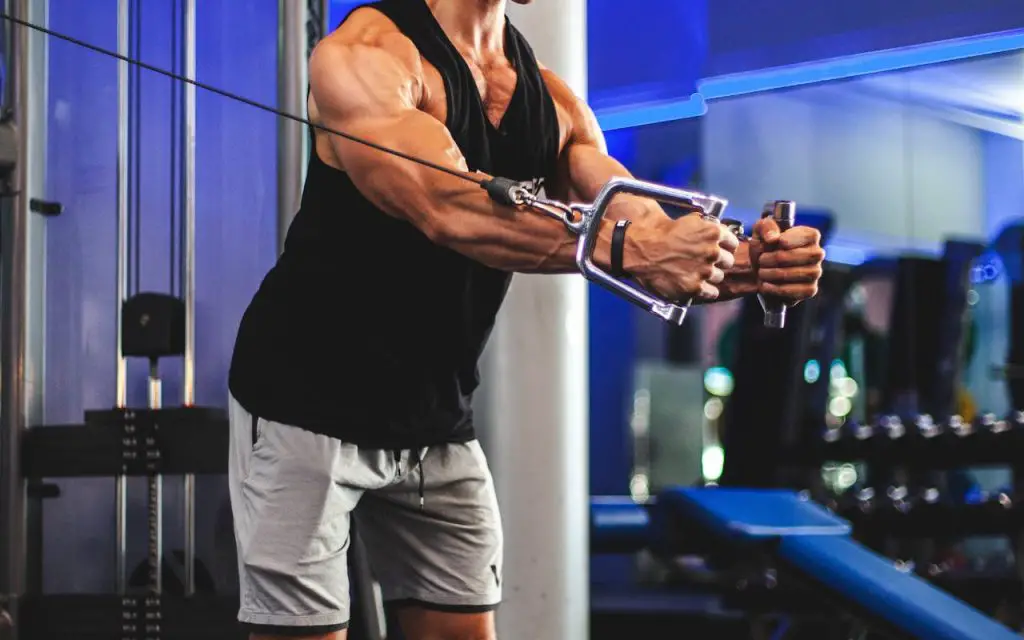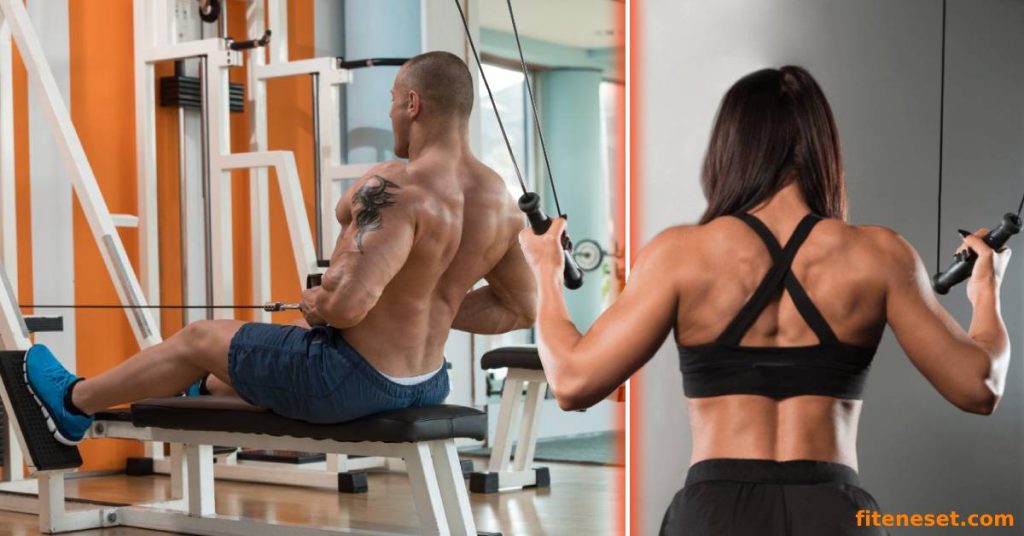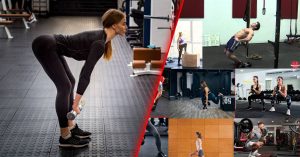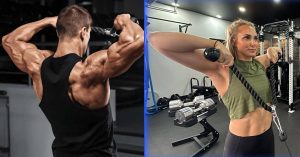Cable machines are not just another piece of gym equipment; they are the unsung heroes that bring a unique twist to your workout routine. Unlike the traditional free weights that work based on gravity, cable machines introduce a constant tension throughout every movement.
This means your muscles are under a steady load from the start of your lift to the very end. But why is this continuous tension so crucial, especially for your back workouts?
Table of contents
MORE keyboard_double_arrow_down LESS keyboard_double_arrow_up
Why Cable Back Workouts?
The unbroken resistance you face during cable exercises ensures that your muscles are working hard throughout the entire exercise. This constant tension is a key driver for muscle growth and can significantly improve your muscular endurance.
Furthermore, with a cable machine, the possibilities are endless. You can adjust the weights quickly, change the angles to target muscles differently, and perform a wide range of movements. This versatility makes cable machines a powerful tool for developing every major muscle group in the back, from the stubborn lower lats to the often overlooked upper traps.
Cable machines also allow for a level of precision in muscle targeting that’s hard to achieve with other equipment. This precision is particularly important for the complex structure of the back, where each muscle group requires specific attention to grow and strengthen effectively.
For example, take a look at this Instagram post by Peter Stringer, an Athlete, where he states how helpful when it comes to achieving your fitness goals:
The Core of Cable Back Training
To truly benefit from cable back workouts, it’s essential to understand the core exercises that make up effective training. Here’s a closer look:
- Lats Focus: Exercises like the wide-grip lat pulldown and the straight-arm pulldown are perfect for widening your back and emphasizing the V-shape.
- Upper Back and Traps: Movements such as the face pull and cable shrug target the upper back and traps, improving posture and upper body strength.
- Rhomboids and Rear Delts: To balance the development, exercises like the single-arm cable row and the prone cable row ensure these smaller but crucial muscles are not neglected.
Each exercise in your cable back workout serves a unique purpose:
- Widening the Back: By focusing on lat-centric exercises, you can create the illusion of a narrower waist and a more pronounced V-taper.
- Improving Posture: Exercises targeting the upper back and traps not only enhance your physique but also contribute to better posture, reducing the risk of back pain and other related issues.
- Building Thickness: For a back that’s not just wide but also thick and powerful, incorporating moves that target the inner back muscles is key.
Now, you might be wondering, how do you integrate these exercises into a cohesive workout plan that maximizes muscle growth and strength? And what is the best way to sequence these exercises for optimal results?
Stay tuned as we dive deeper into creating the ultimate cable back workout strategy. With the right approach, you can harness the power of cable machines to transform your back training, achieving a stronger, more muscular back than ever before.
Key Exercises for a Powerful Back

Wide-Grip Seated Cable Row
The wide-grip seated cable row is more than just an exercise; it’s a fundamental tool for sculpting a wider, more muscular back. The secret to its effectiveness lies not just in the pulling motion but in how you prepare and execute the move from start to finish.
The grip width should be slightly wider than shoulder-width, allowing for a broad range of motion while ensuring the lats are the primary focus. The real challenge, however, comes in maintaining a straight, upright posture.
Slouching or rounding the back can shift the focus away from the lats to the shoulders and arms, reducing the exercise’s effectiveness.
One of the most common mistakes is allowing the shoulders to creep up towards the ears, which not only reduces lat engagement but can also lead to tension in the neck. Another mistake is not fully extending the arms at the beginning of the movement, which deprives the lats of a full stretch.
Single-Arm Cable Row
Achieving a symmetrical back is no small feat, especially when one side tends to dominate the other. The single-arm cable row comes into play as an equalizer, ensuring that both sides of your back are receiving equal attention and effort.
Keeping your torso stationary is more challenging than it sounds, especially as fatigue sets in. One way to ensure balance is to start with your weaker side first, matching the number of reps and weight with your stronger side. This guarantees that your stronger side doesn’t outpace your weaker side, promoting symmetry and balance.
Furthermore, a bonus benefit of the single-arm cable row is the core engagement required to keep the body stable. This not only helps in strengthening the back but also builds a solid core, which is essential for overall fitness and strength.
Wide-Grip Lat Pulldown
The wide-grip lat pulldown is a powerhouse of an exercise, known for its ability to widen the back and enhance the V-taper. However, the true magic of this exercise lies in a detail often overlooked by many.
The key to unlocking the full potential of the wide-grip lat pulldown is in how you pull the bar down. Instead of merely pulling down, focus on pulling the bar towards you while slightly leaning back. This slight adjustment ensures that your lats are fully engaged throughout the movement, maximizing the exercise’s effectiveness.
It’s crucial to keep your shoulders down and back, away from your ears, to prevent unnecessary strain and ensure that the lats are doing the bulk of the work. This focus on shoulder positioning can dramatically increase lat activation, turning a good workout into a great one.
Single-Arm Lat Pulldown
The single-arm lat pulldown is not just an exercise; it’s a precision tool for sculpting your lats. The beauty of this movement lies in its ability to allow a greater range of motion, enabling a deeper stretch and more intense contraction with each rep.
To maximize the effectiveness of this exercise, the trick is to lean slightly into the pull. This subtle adjustment allows you to engage your lats more fully, enhancing the stretch at the top and the contraction at the bottom of the movement. But the secret is all in the grip.
Experimenting with grip variations, such as a neutral grip or a supinated (palm facing you) grip, can significantly affect how the lats are engaged. The right grip can turn a standard exercise into a lat-engagement powerhouse.
Chest-Supported Cable Row
The chest-supported cable row offers a strategic way to train your back without putting undue stress on your lower back. This exercise shines, especially after heavy lifting sessions that tax the lower back, like deadlifts.
The key to targeting different areas of your back lies in the bench and cable adjustments. A higher bench angle targets the upper back and traps, while a lower angle focuses on the mid to lower lats.
The chest support eliminates the possibility of using body momentum, forcing your back muscles to bear the load. This focused engagement ensures that every rep counts.
Straight-Arm Cable Pulldown
The straight-arm cable pulldown is a standout exercise for isolating the lats, crucial for developing that mind-muscle connection. The key to its effectiveness is maintaining straight arms throughout the movement, focusing on moving through the shoulders.
Changing the attachment, from a bar to a rope or even dual handles, can dramatically alter the exercise’s feel and effectiveness. Each attachment option offers a slightly different path of motion and engagement, allowing for nuanced targeting of the lat muscles.
Lying Cable Pullover
The lying cable pullover is a game-changer for lat isolation. Unlike dumbbells, cables provide a constant tension that challenges your muscles throughout the entire range of motion.
Proper setup and execution are critical. The common pitfall? Turning this into an arm-dominated movement. Ensure you’re initiating the pull with your lats, keeping your arms as straight as possible to maintain focus on the target muscles.
But what about the common mistake that shifts the focus away from the lats? Many people bend their elbows too much, inadvertently turning the exercise into a tricep movement. The key is to keep your arms extended and imagine pulling from your elbows, not your hands.
Cable Shrugs
Cable shrugs bring a spotlight to the often-overlooked upper traps. With cables, every lift and lower is a chance to work your traps under continuous tension, something free weights can’t replicate.
The real secret to unlocking the potential of cable shrugs isn’t just in the lift—it’s in the direction of your pull. Adjusting your stance slightly forward or backward can change how the traps are engaged, allowing for a more comprehensive development.
But how exactly does changing your stance alter the focus? By leaning forward slightly, you can emphasize the lower traps, while standing upright targets the upper traps more directly. Experiment to find the stance that best engages your traps, focusing on the squeeze at the top of each shrug.
Cable Face Pull
Cable face pulls are essential for anyone looking to improve shoulder health and posture. This exercise does wonders for the rear delts and traps, crucial for a balanced upper body.
The magic of face pulls lies in the external rotation of the shoulders, which maximizes engagement in the rear delts and traps. However, the common form mistake that reduces effectiveness is not rotating the shoulders enough or pulling too much with the hands.
How can you ensure you’re performing face pulls correctly? Focus on leading the movement with your elbows and imagine trying to pull the rope apart at the end of the movement. This will help increase the external rotation and engagement of the target muscles.
Prone Cable Row
The prone cable row is a stellar exercise for those looking to challenge their mid to upper back without relying on lower body momentum.
This exercise demands a high level of precision and control, as you’re pulling from a stable, prone position. The challenge here is to maintain a neutral spine and use your back muscles, not your arms, to perform the pull.
What’s the best way to incorporate prone cable rows into your routine? Use them as a finisher to ensure your back is fully fatigued, or place them at the start of your workout to activate your muscles for the exercises to come.
By focusing on these techniques and avoiding common pitfalls, you can elevate your back workout to new heights. Remember, the key to progress is not just in the exercises you choose but in how you perform them. Are you ready to take your back workout to the next level with these insights?
Crafting the Ultimate Cable Back Routine

Creating the perfect back workout with cables is an art and a science. The goal is to sculpt a back that’s not just powerful but also balanced and aesthetically pleasing. To achieve this, your workout needs to be meticulously planned, blending various exercises that target every part of your back.
Exercise Selection
Start with vertical pulling exercises like lat pulldowns to widen the lats, then move to horizontal rows to build mid-back thickness. Don’t forget isolation movements to target specific areas of your back.
Workout Sequence
Begin your routine with compound movements that require more energy and strength, such as wide-grip lat pulldowns or seated cable rows. As your workout progresses, shift towards isolation exercises like straight-arm pulldowns or cable pullovers to fine-tune the details of your back.
Variety and Balance
Incorporate a mix of exercises that target different parts of the back. This ensures a balanced development, preventing certain muscles from lagging behind others.
But what’s the optimal way to sequence these exercises to ignite muscle growth and enhance your back’s aesthetics? Find out in the next section.
The Muscle Mechanics in Cable Training
Each muscle, from the broad lats to the intricate rhomboids, plays a pivotal role in your back’s function and appearance.
The lats primarily contribute to the width of your back, traps add to the upper body’s bulk and shape, rhomboids give depth and detail, and rear delts bridge the gap between the back and shoulders, adding to the 3D effect.
Knowing how to engage each muscle group effectively through cable exercises can transform your back workout. For example, using a wider grip can emphasize lat width, while pulling with elbows close to the body targets the rhomboids and traps.
Cable exercises offer unique advantages, such as constant tension and the ability to adjust angles and resistance. This adaptability allows for targeted muscle engagement, which is crucial for addressing weaknesses and capitalizing on strengths. But how exactly do these exercises translate into a stronger, more defined back?
Conclusion
In the journey to back training mastery, cable workouts offer a path filled with variety, challenge, and the potential for significant muscle growth.
Armed with the knowledge of the best exercises, tips for effective training, and answers to common questions, you are well-equipped to enhance your back workouts and achieve the strength and size you desire. The question is, are you ready to put this knowledge into action and see the results for yourself?
Key Points
- Cable machines offer constant tension throughout exercises, enhancing muscle growth and endurance.
- Cable back workouts provide versatility, allowing for targeted muscle engagement across the entire back.
- Exercises like wide-grip seated cable rows, single-arm cable rows, and wide-grip lat pulldowns are essential for a balanced back workout.
- Proper form and posture are crucial in exercises like the lying cable pullover, cable shrugs, and cable face pulls to maximize effectiveness and prevent injury.
- Cable pulls are effective for strengthening the rear delts and traps, supporting improved performance in compound exercises.
- The bent-over row and I-Y-T raises are top exercises for back activation and muscle development.
- Cable machines facilitate muscle building by maintaining constant tension during exercises.
- Due to their fluid motion, cable exercises are considered safer and less stressful on joints compared to free weights.
FAQs
Are Cable Pulls Good for the Back?
Yes, cable pulls are an excellent exercise for the back. They specifically target the rear delts and traps in the upper back, enhancing strength and stability. Incorporating exercises like cable face pulls into your routine can also improve your performance in compound exercises such as deadlifts, bench presses, and overhead presses, making them a valuable addition to any back workout.
What Is the Number 1 Back Exercise?
According to research sponsored by the American Council on Exercise (ACE), the bent-over row and I-Y-T raises are among the top exercises for back training. These exercises provide significant activation for key back muscles, making them highly effective for developing strength and muscle mass in the back area.
Do Cables Build Muscle?
Absolutely. Cable machines are a powerful tool for muscle building. The constant tension they provide during both the lifting and lowering phases of each rep ensures that your muscles are under continuous work throughout the entire set. This constant tension is a key factor in stimulating muscle growth and can lead to significant gains in muscle size and strength.
Are Cable Exercises Safer?
Cable exercises are generally considered safer than free weights due to their fluid and smooth motion. The use of pulleys reduces the direct push or pull against gravity, which can decrease the risk of injury. This makes cable exercises particularly appealing for those looking to maintain joint health while still engaging in intense strength training sessions.

ABOUT THE AUTHOR
Follow Valen Steven for a dose of fitness enthusiasm, evidence-based advice, and a roadmap to achieving your health and wellness goals.
Subscribe to our Newsletter
Dive into a world of fitness and wellness with our exclusive newsletter! Sign up now and receive weekly power-packs of fitness wisdom




